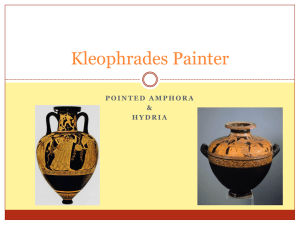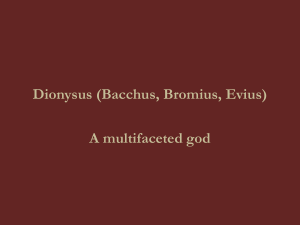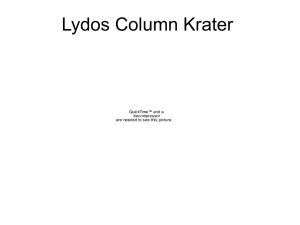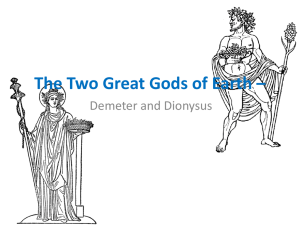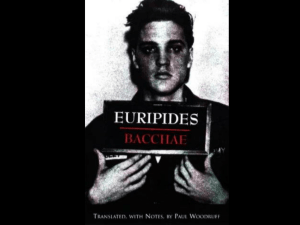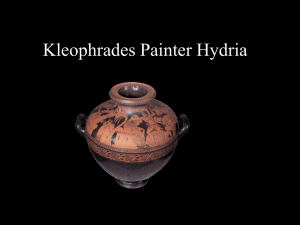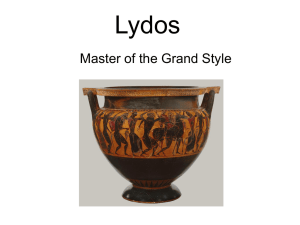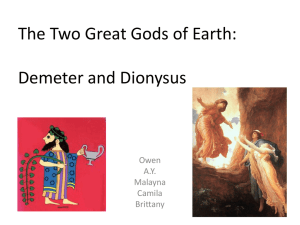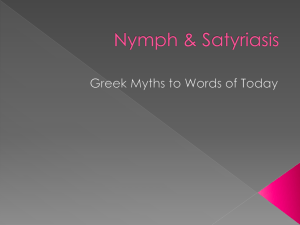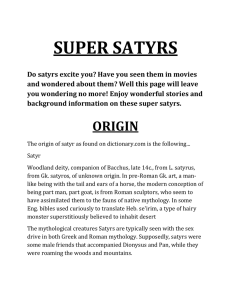Kleophrades Painted Amphora
advertisement
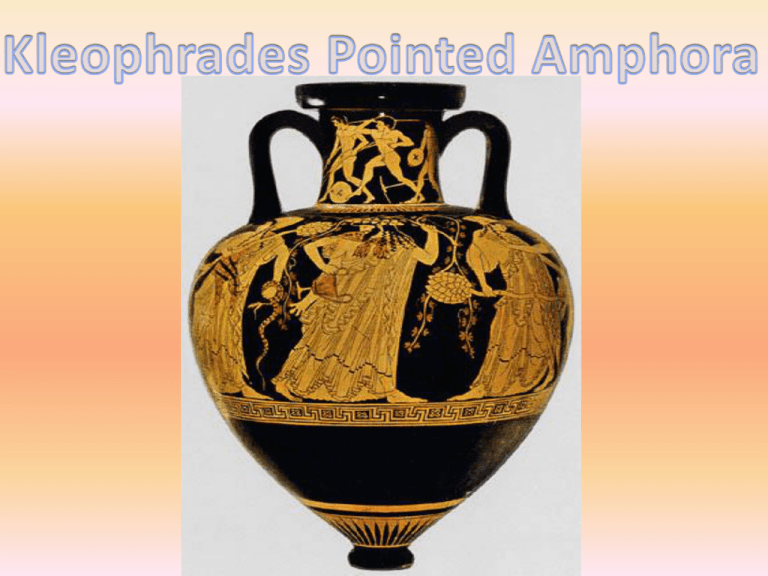
Name: Kleophrades Painter Made: 500-490 BC Size: 56cm Potter: Kleophrades Painter: Kleophrades painter The real name of the Kleophrades Painter is unknown, and he is identified only by the stylistic traits of his work. His name comes from a signature of the potter Kleophrades on a cup now in Paris. Vase shape: Pointed Amphora Used for: storing wine, oil and grains. Difference to other amphorae: different to belly amphora in shape mainly at the foot where the pointed amphora is narrow. Painted amphora were used for ceremonial purposes. Shape and use: Round body, a offset neck with a heavy mouth, handles cylindrical in section and a small knob instead of a stand. It was probably placed on a stand. Identity: Dionysus Who is he? God of wine, theatre, ecstasy Symbols: Grapes, Leopard Skin And a Kantharos (cup used for drinking) Similarity: Ecstatic mood conveyed through lively feet and raised arms. Difference: Dionysus’s clothing portrayed in Lydos is heavy and foldless in comparison to the many lines here. 1) Satyr 2) Mischievous, comical figures ii) Bearded, hairy and animalistic 3) Maenads 4) Female followers of Dionysus. They carry a Thyrsus/sos which is a staff of giant fennel or tipped with a pine cone. • 5) The main frieze depicts an Dionysian revel. Excited satyr is playing a double-flute. • Maenads in orgasmic ecstasy. • Satyrs trying to hump maenads. • Maenads using their thyrsoi to calm satyrs down. • Dionysus carries an empty cup and waves a vine branch. Drunk and merry mood. 6) The neck of the amphora. 7) 3 Athletes depicted with discus and spear 8) Youth after competing shown through the aryballos which contains oil for anointing their bodies after sport. Opposite side shows participating athletes – frontal pose with javelin Possibly given as a prize. 1) Red figure. 2 i) Outlines the figure with a raised line to create a precise border for the shape of the Satyr to be defined ii) Black slip painted on background ii) Deer skin on satyr painted with dilute honey glaze. Colour on the Kantharos being carried by Dionysus creates a metal effect. iv) Grape Vines crown painted purple 3) A dilute slip has been used to give the appearance of lighter hair on the maenad. Black relief line employed to frame the figure as seen around the face of the maenad. 1) 2) 3) 4) 5) The belly of the vase. The Neck. A pattern called Tongues. Meanders pattern. Stylised rays. 5) The main frieze follows an alternating pattern of female and males figures. Overlapping is used where a thyrsus is in front of a grape vine. Spaciousness of composition- There’s plenty of room. 7) The neck is sharply set off from the body which tapers to a very small foot thus it would have been difficult to paint the section of the main frieze below the neck due to the curve approaching from the belly. 1) Open at the inner corners, pupils well forward with a profile gaze. 2) Continues to incise hair- marks the hair with a series of lines 3 i)Athletes convey realistic poses with a range of body views and foreshortening- evidence of Kleophrades anatomical skill. ii)Bodies of Dionysus, Maenads and Satyrs are in proportion 7) Drapery -Folds, billowing, overlapping, revealing body. Fine, precise detail depicted Has used the drapery to display the movement of the character in the folds. 1) Post orgasmic glow 2) Ecstatic , happy. A)Beside each maenad was a inscription of the word ‘kale’ meaning beautifuladds to mood of the vase. B)Ithyphallic C)Maenad in throes of orgasm- mouth open in a scream, foot raised. D & E) Aroused satyr trying to get in the maenads pants shown through the placement of his hands and his body position and lacking sexual restraint. F & G) Grapes-wine-drunk. Kantharos is used for drinking Wine and it is currently empty implying Dionysus has been drinking. Mood is mainly of revelry, ecstasy and drinking reinforced by the joyous maenads dancing and sexual advances from the satyrs and also the symbolism of the grapes.
